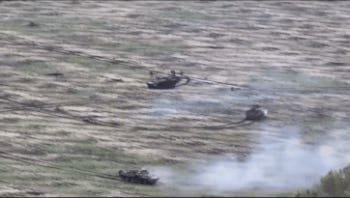Russian marines apparently backed by North Korean reinforcements threw themselves at Ukrainian positions in Kursk Oblast in western Russia on Thursday.
It was a bloodbath for the Russians. But don’t expect them to stop attacking. The politics of Russia’s 33-month wider war on Ukraine are in flux now that Republican Donald Trump has won the presidential election in the United States.
Trump has vowed to end the war in Russia before his inauguration in January. The Wall Street Journal obtained the details of Trump’s plan—and they incentive the Russians to attack as hard as they can as fast as they can in Kursk, losses be damned.
That’s because one of Trump’s proposals is for Ukraine and Russia to agree to an armistice along the current front line. And the current front line threads through southern and eastern Ukraine before looping into Kursk, where a powerful Ukrainian force invaded back in August.
If Trump’s plan actually works—and that’s a very big if—Russia would effectively surrender 270 square miles of Russian soil in exchange for the roughly 20 percent of Ukraine—that’s 45,000 square miles—it occupies.
Russian Pres. Vladimir Putin might blanche at this seemingly favorable exchange: he previously demanded his forces eject Ukrainian troops from Kursk by Oct. 1—a deadline the Russians obviously missed.
The Russian 810th Naval Infantry Brigade with its attached North Koreans, who arrived at the front last month, wasn’t the only Russian unit to counterattack the Kursk salient on Thursday, but it may have been the most unfortunate.
According to Kriegsforscher, a Ukrainian drone operator who is supporting the Ukrainian brigades in Kursk, the 810th Naval Infantry Brigade recently received a batch of 40 BTR-82 wheeled armored personnel carriers to make good some of the losses it has suffered while trying and failing to dislodge the Ukrainians in Kursk.
At least 14 BTRs targeted the Kursk salient’s left flank on Thursday. “Ten of them are destroyed or damaged and abandoned,” Kriegsforscher reported. As many as 10 troops can squeeze into the 17-ton vehicles, meaning the 810th Naval Infantry Brigade could’ve lost 140 troops in total, although it’s likely at least a few escaped their burning BTRs.
Kriegsforscher anticipated further assaults on the salient, and in the same places the Russian marines just attacked in their BTRs. “As I said before, [the] left flank and the center will be the hardest places in Kursk Oblast,” Kriegsforscher noted.
The Kremlin may accept heavy casualties as it tries to eliminate the Kursk salient. The trade—eliminating the salient in exchange for hundreds or even thousands of lives—might be worth it to Russia’s leaders, but only if there’s a realistic prospect of Trump’s peace plan going into effect.
It’s not clear that’s the case. The main problem is that Trump is reportedly demanding a demilitarized zone all along the 800-mile front line, but isn’t proposing any way of enforcing it.
“A demilitarized zone requires an enforcing presence to ensure compliance,” pointed out Tatarigami, a Ukrainian analyst. “Without a security force on the ground, it risks being ignored or frequently violated.”
For that reason, Trump’s purported peace proposal is “naive,” Tatarigami explained. Russia and North Korea may be hurling troops and vehicles at the Kursk salient in an attempt to set conditions for an armistice that may never come.
Read the full article here





